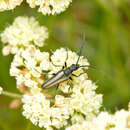Conservation Status
provided by University of Alberta Museums
Not of concern.
- license
- cc-by-nc
- copyright
- University of Alberta Museums
Cyclicity
provided by University of Alberta Museums
Adults common from May to August (Gardiner 1970; Linsley and Chemsak 1972).
- license
- cc-by-nc
- copyright
- University of Alberta Museums
Distribution
provided by University of Alberta Museums
The type locality is the Yellowstone Basin (LeConte 1873). Specimens have also been recorded from Alberta, British Columbia, Washington, Wyoming, Idaho, Oregon, Colorado and Nevada (Barr and Penrose 1969; Canorva 1936; Hopping 1937; Linsley and Chemsak 1972).
- license
- cc-by-nc
- copyright
- University of Alberta Museums
General Description
provided by University of Alberta Museums
"Length 10-17 mm (Linsley and Chemsak 1972). The head is narrowed posteriorly and rounded laterally (Leng 1890). The eyes are small, convex, and finely granulated (Casey 1913). The third and fifth antennal segments are equal in length; the fourth antennal segment is two thirds as long as third and fifth (Casey 1913). The eleventh antennal segment is longer than the tenth (Linsley and Chemsak 1972). A very fine pubescence covers the body (Leng 1890); the head is fuscous, and the posterior body is testaceous in color (Casey 1913). The elytra are narrowed and rounded at the tip, the sutural angle is obtuse (Casey 1913). The prothorax is shorter than it is wide; it surface convex; constricted anteriorly and posteriorly and bisinuate laterally (Casey 1913). The lateral protuberance is not well developed and the lateral tubercles are obtusely rounded (Casey 1913).
S. obtusus are very sexually dichromatic (Linsley and Chemsak 1972). Males may be all black or pale with black appendages and vittate elytra. Females have a uniformly yellowish elytra and reddish appendages and prothorax (Linsley and Chemsak 1972). However dichromatic characteristics are not universal, few male specimens have been identified with unicolorous elytra and few female specimens have been identified with vittate elytra (Hopping 1937).
S. obtusus can be distinguished from similar species by the small, convex eyes (Leng 1890); evenly rounded elytral apices (Linsley and Chemsak 1972), and the lateral edges of pronotum having obtusely rounded tubercles (Linsley and Chemsak 1972)."
- license
- cc-by-nc
- copyright
- University of Alberta Museums
Habitat
provided by University of Alberta Museums
Found in sub-alpine meadows on soil surface or on the stems and flowers of various angiosperms.
- license
- cc-by-nc
- copyright
- University of Alberta Museums
Life Cycle
provided by University of Alberta Museums
Most cerambycid larvae are wood boring and may be very destructive to trees impacting forestry and agriculture (Triplehorn and Johnson 2005).
- license
- cc-by-nc
- copyright
- University of Alberta Museums
Trophic Strategy
provided by University of Alberta Museums
All cerambycids are phytophagous and most Lepturinae larvae are wood borers (Borror and DeLong 2005). Stenocorus obtusus adults can be found on stems of Lupinus sp. (Linsley and Chemsak 1972), or on the flowers of Achillea, Heracleum, and Galium (Linsley and Chemsak 1972).
- license
- cc-by-nc
- copyright
- University of Alberta Museums
Stenocorus obtusus
provided by wikipedia EN
- license
- cc-by-sa-3.0
- copyright
- Wikipedia authors and editors
Stenocorus obtusus: Brief Summary
provided by wikipedia EN
Stenocorus obtusus is a species of beetle in the family Cerambycidae. It was described by John Lawrence LeConte in 1873.
- license
- cc-by-sa-3.0
- copyright
- Wikipedia authors and editors

